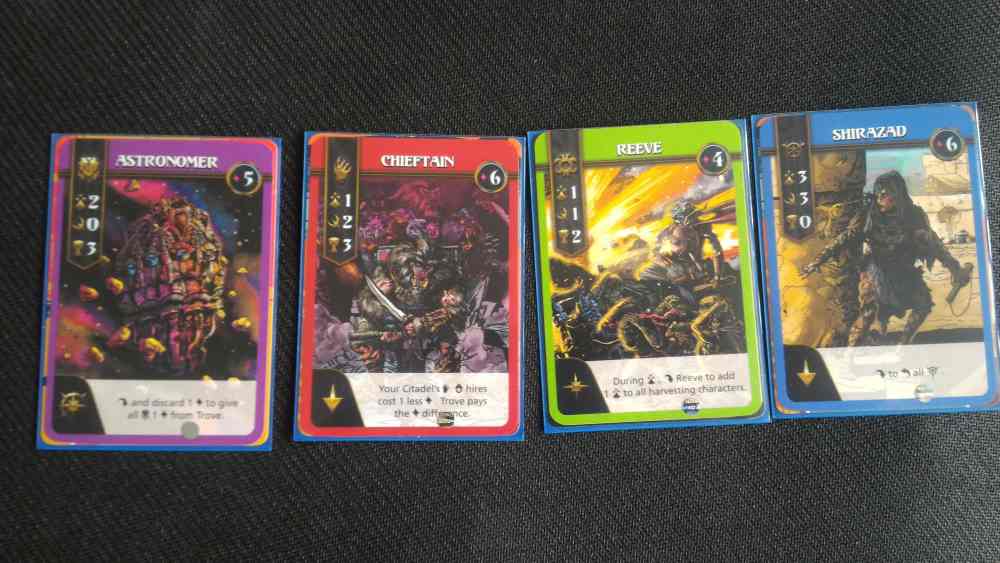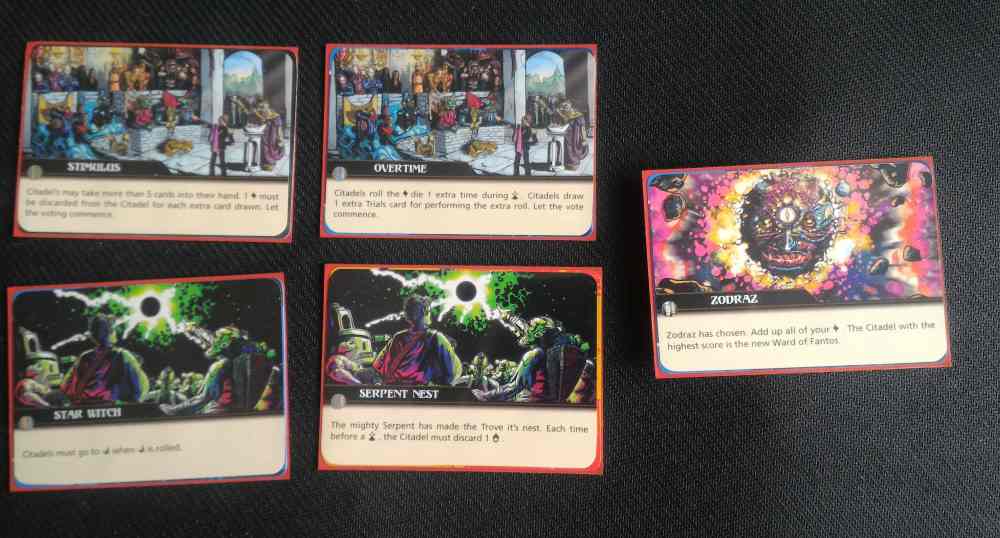
Savage Planet: Fates of Fantos is a competitive card game with cooperative elements. Set in a world with a vengeful god and depleted resources, players are vying to survive “The Great Cull.” It’s a card game for three to six players, and designers Imp House are looking for funding on Kickstarter, now. They have already exceeded their modest funding target.
New to Kickstarter? Check out our crowdfunding primer, and visit our curated page for more projects we love.
Overview:
The planet of Fantos is dying. Warring “Citadels” have stripped the world of its resources. The vengeful god, Zodraz, is displeased and will wipe the scourge from his beloved Fantos. The god has decreed that only one ‘Citadel’ will remain after he reforges the planet.
Each players in the game takes control of one Citadel. They must compete to build up the largest stock by of “Shards,” so that Zodraz takes their Citadel into the new world. To do this, players hire numerous “Legacies” to help collect the game’s currency. The Citadel with the highest total of Shards at the end of the game is the winner.
Legacies can be given various tasks. Harvest more Shards from the planet’s resources, go to war with a neighbor, or be used as tribute – to win favor from Zodraz.
Every time a player chooses to Harvest the precious resources of Fantos it increases the planet’s pollution, making Zodraz yet more irate. His unleashing of plague and other trials on the Citadels of Fantos makes life collectively tougher for all the players. Eventually, once Zodraz has unleashed many trials, he will come to Fantos to pass judgment, destroying all but the most powerful of Citadels.

Components:
36 Legacy Cards.
45 Labor Cards.
20 Trials Cards.
1 Shard Die (a D3).
150 1 Shard Counters (pink).
50 5 Shard Counters (blue).
1 Tribute Token.
1 Player One Token.
6 Citadel Mats.
How to Play:
Savage Planet consists of several phases. Cards have symbols on them that indicate in which phase they can be played. These are either in the Fantos Action Phase (the main phase of the game,) the Secondary Action Phase, or there are “Instant” cards which can be played at any time.
In a single round, cards can usually be played once only. In which case they are “tasked;” turned on their side. Very similar to “tapping” in Magic: The Gathering.
The “Legacy” cards are what drive the game. These are what you use to earn shards or to fight your opponents. Each Legacy card has a cost, which is what must be paid to play it. Legacies are bought using your Citadel’s reserve of Shards. The Shards spent recruiting the card are placed on the card and can be used to purchase Labor cards. These Shards (those placed on the Legacy) also act as health for each Legacy. Legacies have three different attributes, Harvest, War, or Tribute. The higher the number for each attribute, the better they are at that particular task.
“Labor” cards are more like general workers. Imagine that Legacy cards are a Citadel’s Mayors, Overseers, or Chief Scientists; the Labor cards are their workers. These can be paid for only by Shards from the Legacy cards that hired them.
The “Trials Deck” represents Zodraz’s displeasure with the denizens of Fantos. They provide global effects that will (usually) be detrimental to all players. Players can work together to prevent them, but they don’t have to. Some trials will hit some Citadels harder than others.
The game is set up by dealing out 5 Labor cards to each player and setting up the various decks. Each Citadel is given 30 Shards with which to buy their Legacies. Legacies are purchased from a central pool, which is replenished from the Legacy Deck every time a Legacy is purchased. There is an initial phase where players purchase their first three legacies. The Zodraz Card is placed randomly in the last five cards of the Trials Deck. Players know he’ll come out towards the end of the game, but not exactly when.
The Zodraz Card is placed randomly in the last five cards of the Trials Deck. Players know he’ll come out towards the end of the game, but not exactly when.

Phases of Play: Players take turns, starting with the player who has the most Shards left after the Legacy purchase phase during setup.
1: Untask and Draw Up: Any cards tasked during your previous turn are untasked and can be used again this turn. If you have less than 5 Labor cards you may draw back up to 5.
2: The Fantos Action: The main part of the game. The active player can choose to task Legacies to do ONE of the following each turn. Harvest, War or Tribute. More than one Legacy can be tasked (with the points of the relevant attribute being totalled,) but they must all help do the same thing. Tribute is an exception to this. Only one Legacy from each Citadel can be sent as Tribute.
Players can also use Labor cards at this point to boost an attribute or help them with the Fantos Action they have decided to use.
Players may choose not to take a Fantos Action at all.
The Fantos Actions:
Harvest: The player may harvest some shards. This is equal to the total of the Harvest attributes of all the Legacies being used, plus any Labor card boosts, plus one roll of the Fantos Die (adds 1-3.)
The harvested Shards are placed in the Citadel’s coffers.
War: A player may choose to attack another Citadel. The attacking player chooses which of his Legacies to attack with (generally the ones with high War scores.) The defending player may (but doesn’t have to) choose Legacies to defend with.
Both sides roll the Fantos dice to add 1-3 points to their war score. War scores equal the total of the War attributes of the Legacies attacking/defending, plus any Labor card boosts, plus Fantos Die score. Defending Legacies are also tasked.
The highest score is the winner, with the difference between the two being the Damage Score. The losing Citadel must remove that many Shards from the Legacies involved in the War. If a Legacy is completely depleted it is destroyed. Remaining damage is taken directly from the Citadel’s reserve.
The spoils of war, (the number of Shards taken) are given to the victor and added to the Citadel’s reserve. If a Citadel’s Shard total is reduced to zero (at any point in the game,) that player is eliminated.
Tribute: Works very similarly to War, except any number of players may attempt to gain favor, once somebody has declared they wish to pay tribute. Players do not have to take part if they do not wish.
Only one Legacy can be used for Tribute, so you cannot combine Tribute scores from several Legacies. The Shard Die is rolled and added to the participating Legacies’ Tribute attribute. Boosts are still possible from Labor cards. The winner is the Legacy with the highest Tribute score.
The winning Citadel may claim their Tribute score in Shards from one of the other players. That Citadel is also given the Reigning Tribute token, which gives several small advantages to that Citadel, until such time as a new Legacy wins Tribute.

3: Trials Phase:
If a player has chosen Harvest, the top card of the Trials Deck is turned over. This must be immediately resolved, and its effect may be ongoing.
There are two types:
Diplomacy Cards: The effects of Diplomacy Cards are voted on. If the card wins the vote, its effects are immediately put into play. If not, the card is discarded. A tie means the vote is lost.
Cosmic Cards: These are world events and happen immediately. The cards stay in play until the conditions are met for discarding them. Players will often have to work together to do this.
The Zodraz card is a Cosmic Card. One that triggers the end of the game.
4: Secondary Action Phase:
Some cards have secondary actions. These are carried out in this phase.
5: The Hiring Phase:
Players may choose to hire new Legacies if they wish, using Shards from their Citadel’s reserve. This is done by paying card’s Shard cost. This legacy arrives Untasked.
6: Discard:
Players may discard as many of their Labor cards as they wish. They will draw back to five at the start of their next turn.
Once a player has been through each of these phases, the turn passes to the next player.
Winning the Game:
If all the Citadels except one are eliminated before the Zodraz card is revealed in the Trials deck, the remaining Citadel wins. If the Zodraz card does turn up, any remaining players total their number of Shards. The Citadel with the highest number becomes the new Warden of Fantos; the others are consumed to fiery oblivion.

The Verdict:
One of my favorite things about Savage Planet: The Fate of Fantos is the aesthetic. It’s one of a kind. The stylized artwork gives the game a feel that is very much its own. One very much feels like part a denizen of the planet Fantos when playing.
I’m a big fan of games that have cooperative and competing mechanics. It makes things a little more interesting than just playing against one another, or all working together all the time. Savage Planet doesn’t quite give the backstabbing opportunities of Germania Magna. But I like the co-op mechanic of working together against the Trials Deck. There is also a nice dynamic built up around, who to go to War with and when to do so. Also, you have to pick your time to call for Tribute, and, should you win, who to claim the bounty from.
The game has quite a steep learning curve, though the revised rulebook does make proceedings much clearer. I went wrong the first couple of times I played, but with the revisions the team have made, I don’t think I would now.
Savage Planet is not a quick game. 45 – 90 mins is the given time. I think most of our games have been 90+, but a number of my group are given to analysis paralysis, myself included. It’s a game that invites deeper thought, which is great for some players, but is not necessarily for everybody.
It is however filled with fresh ideas, with a striking and bold aesthetic. The team have put a huge amount of effort into their game, and have been rewarded with having already reached their funding target. Keen to know why? Do pop along to their Kickstarter, now.
Disclaimer: I received a prototype copy of the game in order to write this review.



